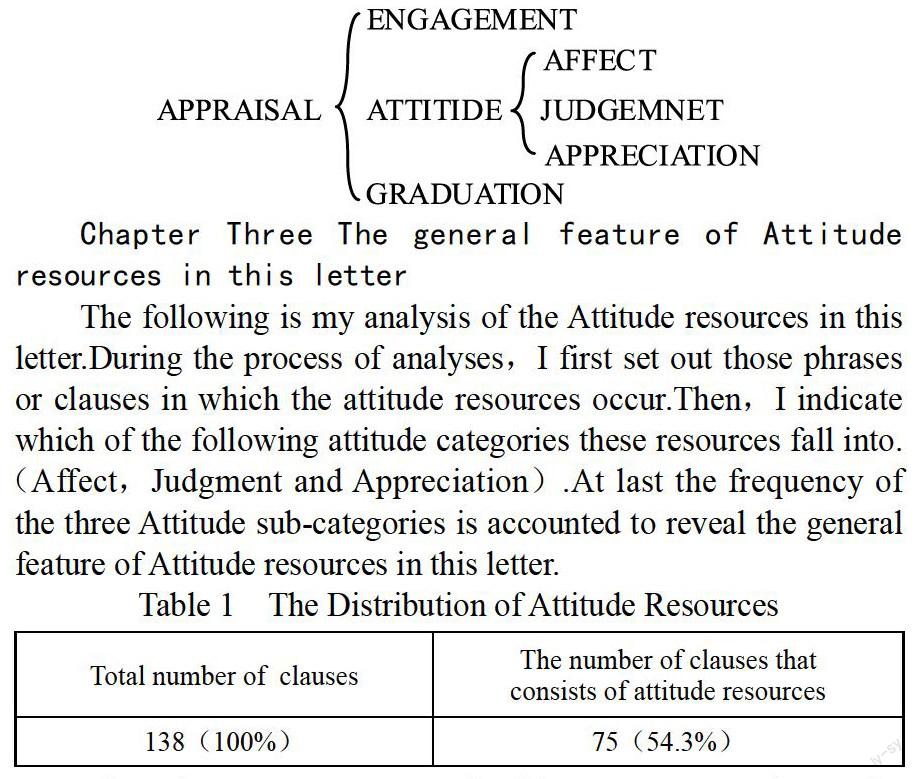The Analysis of the attitude resources in A Letter to Chiang Ching—Kuo from the Perspective of Appraisal Theory
2015-05-30王璇万蕾
王璇 万蕾


【Abstract】Martins Appraisal theory is the latest development to the SFL model of interpersonal meaning.With the development of Appraisal theory,it is applied widely in various areas,especially in discourse analysis,but few applications of Appraisal theory to Chinese discourse can be found to date.This thesis attempts to use the Appraisal theory to analyze one Chinese discourse《致蒋经国信》.
【Keywords】Appraisal theory Attitude resources
【基金项目】该文为湖北医药学院校级科研启动基金资助。
【中图分类号】H13 【文献标识码】A 【文章编号】2095-3089(2015)19-0003-01
Chapter One Introduction
With the development of Appraisal theory,it is applied widely in various areas,especially in discourse analysis.However,by far most researches are only concerned with English discourse.We hold that Chinese discourses also incorporate the interpersonal meanings and it is worth exploring how these meanings are realized.So thesis attempts to explore the interpersonal meanings in a Chinese discourse by the tool of the Appraisal theory.The Chinese discourse chosen in this thesis is A Letter to Chiang Ching-Kuo.This discourse is namely a letter written by Liao Chengzhi to Chiang Ching-Kuo.It is a very famous and influential discourse in the history of communication between Mainland and Taiwan and once acted as a medium for interaction and negotiation between the Communist party and Kuomingdang.This study can test if the application of the Appraisal theory on Chinese discourse analysis is feasible.This thesis only focuses on the ATTITUDE resources.
Chapter Two Theoretical Framework:the Appraisal System
Martin introduced the appraisal framework in the early 1990s,but more recently White(1998)has developed much energy and effort to refining the system.The framework is located within the framework of Systemic Functional Linguistics.The primary impetus for its development has come from work conducted in the 80s and 90s for the Write It Right project of the NSW(New South Wales)Disadvantaged Schools Program.The following figure is the model of Appraisal as in Martin and Rose(2007):
Chapter Three The general feature of Attitude resources in this letter
The following is my analysis of the Attitude resources in this letter.During the process of analyses,I first set out those phrases or clauses in which the attitude resources occur.Then,I indicate which of the following attitude categories these resources fall into.(Affect,Judgment and Appreciation).At last the frequency of the three Attitude sub-categories is accounted to reveal the general feature of Attitude resources in this letter.
Firstly Table1 shows that the frequency of attitude resources in this letter is high.More than half of the clauses contain attitude resources.This is connected with the purpose of this letter.This letter is aimed at expressing the authors opinions and persuading readers to accept them.This purpose determines that in this letter the author should not just describe the facts.However,it should take a clear stance towards some facts and express his attitude.Thus,the letter contains a lot of Attitude resources.
Secondly,Table2 reveals the general and remarkable tendency of Attitude resources in this letter.It shows that the frequency of three Attitude sub-systems changes systematically.The frequency of Affect is lowest(about 18.7%),followed by Judgment(about 36%)and Appreciation(about 45.3%).The instances of Affect are far outnumbered by Appreciation and Judgment.The reason might be as following:
Affect is concerned with emotional states and responses,while Judgement is concerned with normative assessments of human behaviour.Thus under the Affect,evaluation is explicitly that of some human subject,the individual or group which is represented as making this or that emotional response or being in this or that emotional state.Affect therefore is very explicitly subjective.In contrast,Judgment is not so explicitly located in the consciousness or subjectivity of a specified human participant since Judgment values are presented as qualities of the phenomenon being evaluated rather than of the person doing the evaluating.Thus the Affective value of “loving” in “Everyone loves Fred” is a quality or property attributed to “everyone”(the emoter /appraiser)while the Judgment value of “genius” in “Fred is a genius” is a quality attributed to Fred(the appraised).
So by employing more Judgment and Appreciation resources than Affect resources,the author objectifies his opinions and makes them more easily be accepted by the readers.
References:
[1]Martin,J.R.and Rose,David.Working with Discourse:Meaning beyond the Clause [M].Beijing:Peking University Press,2007
[2]李战子.评价理论:在话语分析中的应用和问题 [J].外语研究,2004,5:1-6
[3]王振华.杂文中作者的介入 [J].暨南大学华文学院学报,2002,1:58-64
猜你喜欢
——生态学
——马克思主义学科
